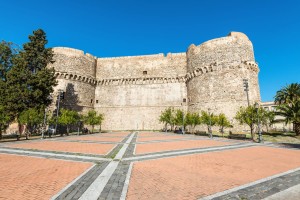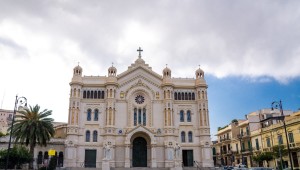
©Bigstock.com/byvalet
Italy’s south is home to the country’s oldest ancient settlements that left marks which you can still delightfully explore and marvel at to this very day. If you feel like a cultural holiday and are historically minded, we recommend the city of arts Reggio Calabria. The largest city of Calabria and former capital of the region – that honour went to Catanzaro in 1970 – is situated at the east side of the Strait of Messina. You can comfortably reach the Sicilian city by ferry in just 20 minutes which lends itself perfectly to an artful, cultured double city holiday. You will find vast ancient heritage, diverse architecture and of the most beautiful promenades in the entire country in Reggio Calabria. Let’s get to it!
Greek roots in Calabria
There’s most certainly plenty of history in Reggio Calabria. Its predecessor, Rhegion, was one of Italy’s oldest Greek colonies aside from Cumae. Likely founded around 720 BC by settlers from Chalcis, it saw a massive boom period thanks to busy trade activities and a fleet of 70 battleships at times. Conquered and destroyed after severe combat by Dionysius I of Syracuse – Rhegion had allied itself with Athens against Syracuse – in 387 BC, the now enslaved population lost all its wealth. It eventually fell to the Romans just before the First Punic War, became a flourishing city under the name of Rhegium Julii and, after the fall of the Western Roman Empire and several invasions, was eventually made a Byzantine property.
The following centuries turned out highly eventful. Reggio Calabria was conquered by Sicilian Arabs in 918, received some Norman touches and was eventually incorporated into the Kingdom of Sicily and the Kingdom of Naples. It maintained its Greek undertones until the 17th century and even survived looting by the Osman Turks who planned to spread Islam across Italy from here. After the Habsburg, Spanish and Napoleonic reign Reggio Calabria eventually became part of the united Italy. Struck by brutal earthquakes as early as ancient times, the severe 1908 Messina earthquake with its tsunami destroyed most of the city. At least a third of the population lost their lives. That’s why numerous sights in Reggio Calabria have a decisively more modern look.
A walk on the beach
Reggio Calabria is situated directly at the ocean and has countless beaches that lend themselves to a dip in the water – certainly essential in the hot summer months. An extended walk at the carefully restored beach promenade is just as neat. Built at the tail end of the 18th century as a central hiking trial through the then village, you get to see numerous villas and astonishing buildings. Artfully decorated facades will wow you over and over again. Among the highlights is the seaside amphitheatre, one of Reggio Calabria’s most popular event venues. Aside from all the representative buildings, the numerous clubs and beach bars, you shouldn’t forget to look out into the sea. On clear days – and there are more than enough here – you can easily see Messina.
Museo Nazionale della Magna Grecia
We initially recommended the city of arts Reggio Calabria to you as a wonderful cultural and historical destination. The main reason for that is hidden behind the walls of the national archaeological museum, also known as Museo Archeologico Nazionale di Reggio Calabria or MArRC. The building – designed in 1932, completed in 1942, but empty for several years until way after the war – looks rather unspectacular from the outside. The four floors of this extensively renovated museum has all the history of Reggio Calabria you need from its earliest Greek settlements to more modern times. The ground floor with its 15 halls is dedicated to finds from the Sibari plain and from Locri with various items from Greek sanctuaries and a reconstructed rock-cut tomb. Ancient Reggio Calabria and a fascinating collection of old coins are situated on the first floor, while the region’s art history from the Middle Ages to the present is being told on the second floor.
The absolute highlight, without any doubt, can be found in the basement, the perfect place for an exhibition titled “underwater archaeology”. You will see finds from the Calabrian seas and from sunken ships, such as amphorae and anchors from Greek and Roman times, in the first two halls. Hall III, however, manages to top that. Aside from the head of the philosopher found in Porticello and a 5th century BC sculpture of a ruler, you get to marvel at the Bronzes of Riace. They were found outside the coast of Riace in the Province of Reggio Calabria in 1972 and carefully restored over several years. The statues, both around two metres in height, likely used to carry wooden shields and cutting weapons. They might have been consecration gifts for a temple and could have been placed on pedestals.
More sights in Reggio Calabria

©Bigstock.com/Aliaksandr Antanovich
While the archaeological museum of Reggio Calabria is a must-see for sure, this city of arts is home to many more glorious sights we simply have to tell you more about:
- Duomo di Reggio: Basilica Cattedrale Metropolitana di Maria Santissima Assunta in Cielo, the city’s cathedral, is one of the buildings that was severely affected by the 1908 earthquake. What started around 300 AD on the ruins of a Greek temple and saw many a restructuring and expansion over the centuries had to be fully rebuilt in the 20th The now neo-Romantic cathedral with its 28-m-high campanile at least managed to retain some of its 15th and 16th century endowments. The richly decorated front portal alone is worth the visit.
- Madre della Consolazione: Another destroyed building is this 16th century votive church. Provisionally stabilised as a wooden church for decades, the new pilgrimage church has a decisively mode modern touch creating a fascinating contrast to Reggio Calabria’s ancient roots. The altarpiece, a painting of the Maria della Consolazione, is part of a procession that sees it carried to the cathedral in September and returned in November. This commemorates centuries long gone when the piece was repeatedly brought to the Duomo di Reggio during epidemics.
- Castello Aragonese: Our final stop is another landmark sight of the city of arts Reggio Calabria. Fortified structures likely existed as early as ancient times. Back then the hill on which this fort now rests was far more striking. While its name is due to heavy architectural alterations under King Ferdinand I of Aragon, who had the striking round bastions with merlons built, the actual origins of the fort likely lie somewhere between the 9th and the 11th century, in Byzantine times.
The rich, multifaceted Greek heritage, plenty setbacks and austerity, but also pure euphoria and maritime bliss accompany your tours of the city of arts Reggio Calabria. Experience Calabria’s largest city in all of its glory and variety between invaluable statues, majestic views and mighty fortress walls. An additional trip to Messina by ferry is a welcome bonus – time to plan your next holiday!